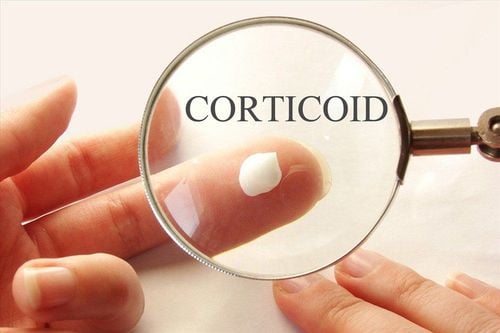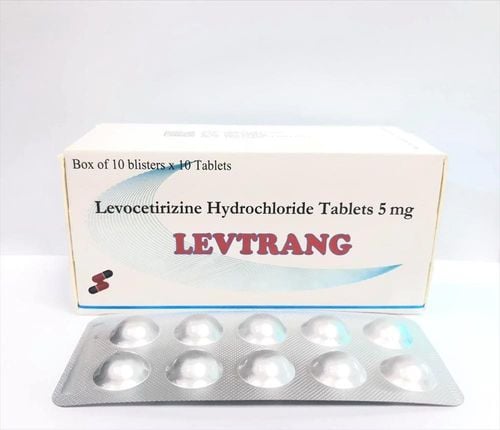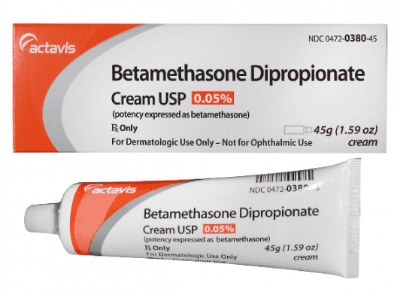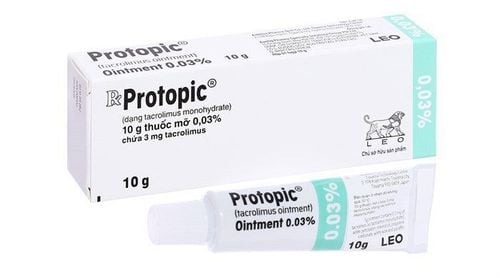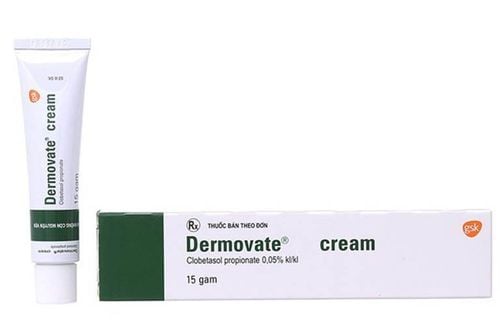This is an automatically translated article.
Knevate is a topical corticosteroid, usually indicated in adults and children 1 year of age and older for the short-term treatment of moderate to severe skin diseases that have responded to corticosteroids. The following article provides information for readers about the dosage and precautions when using Knevate.1. What effect does Knevate have?
Knevate medicine has the main ingredient is Clobetasol propionate, is prepared in the form of a topical cream, each tube of Knevate 10mg contains Clobetasol propionate 0.05%. Clobetasol propionate is a synthetic corticosteroid similar to prednisolone, with potent glucocorticoid activity but weak mineralocorticoid activity. Clobetasol propionate is used topically to treat a number of different skin conditions.
Like other topical corticosteroids, Clobetasol propionate has anti-inflammatory, pruritus, and vasoconstrictor effects. The exact mechanism of the anti-inflammatory action of topical clobetasol propionate in the treatment of corticosteroid-responsive dermatoses is not well defined. It is possible that Clobetasol propionate induces proteins collectively known as lipocortin, which inhibit phosphorylase A2. These proteins control the biosynthesis of potent inflammatory mediators such as leucotrienes and prostaglandins, by inhibiting the release of arachidonic acid, a common precursor of leucotriene and prostaglandins. Arachidonic acid is released from membrane phospholipids by phospholipase A2.
2. Indications and contraindications for taking Knevate
Indications
Knevate is a topical corticosteroid, usually indicated in adults and children 1 year of age and older for the short-term treatment of moderate to severe skin diseases that have responded to corticosteroids. Skin conditions include:
Psoriasis (excluding widespread plaque psoriasis). Eczema is persistent and difficult to treat. Flat lichen . Discoid lupus erythematosus. Other skin conditions unresponsive to less active corticosteroids. Contraindications to the use of Knevate:
Hypersensitivity to Clobetasol propionate, other corticosteroids or any component of Knevate. Do not use Knevate for children under 1 year, including dermatitis and diaper rash. Treatment of acne, rosacea, perioral dermatitis, itching around the anus and genital area, primary viral skin infections (chicken pox, herpes simplex). Knevate should not be used alone to treat extensive psoriasis. Knevate should not be used in the treatment of primary infectious skin lesions caused by fungi or bacteria. Infection is mainly in the scalp area. Knevate should not be applied to the eyes, face, groin, armpits, or vaginally. Knevate should not be taken orally.
3. How to take Knevate
Apply a thin layer of Knevate cream and gently massage on the affected area, 1-2 times a day until symptoms improve. Then, reduce frequency of use or replace with another less effective corticosteroid. Repeated short-term treatment with Knevate cream is applied to control disease aggravation.
In resistant cases, especially when there is hyperkeratosis syndrome, to increase the therapeutic effect of Knevate, the application area can be covered with polythene film. Overnight occlusion usually achieves the desired therapeutic response. After improvement of symptoms, Knevate can be continued without the need to cover the area of application. After 2 - 4 weeks of using Knevate with no response or worsening symptoms, the diagnosis and treatment should be reviewed.
A course of treatment with Knevate should not exceed 4 weeks, in case of needing to continue treatment, a weaker corticosteroid should be used.
Only apply a sufficient amount of Knevate cream on the affected area, not more than 2g/time. If the affected area is too large, do not use more than 50g per week.
Sudden discontinuation of Clobetasol propionate may cause recurrence of skin diseases.
Adult dosage
You can determine the amount of Knevate to take using the Fingertips technique:
Face and neck: 2.5 FTU. Back: 7 FTUs. Chest and abdomen: 7 FTUs. One arm (not including hand): 3 FTU. Both sides of hand: 1 FTU. One foot (foot not included): 6 FTU. One foot: 2 FTUs. Children:
Contraindicated to use Knevate cream for children under 1 year old. The risk of systemic effects with the use of Clobetasol propionate is greater than in adults, thus requiring a shorter duration of treatment and the use of other less effective corticosteroids. The duration of the Clobetasol propionate course of treatment should not exceed 5 days and the area of application should not be covered with a bandage. Only the minimum amount of Clobetasol propionate should be used for effective treatment. The younger the child, the less the amount used. Using the drug on the face:
The duration of a course of Knevate drug treatment should not exceed 5 days and do not cover the application area. Do not let Knevate cream get in your eyes. In case of eye contact, rinse eyes with clean water. Persistent eczema:
Patients with frequent relapses: After an acute episode is effectively treated with Clobetasol propionate, the drug can be continued at intermittent doses (1 time/day x 2 days//day/day/day/day/day/day/day/day/day/day/day/day/day/day/day/day/day/day/day/day/day/day/day/day/day/day/day/day/)" weeks, do not cover the application area) to reduce the frequency of recurrence. Knevate cream should be continued to be used on affected areas and areas likely to recur. The above regimen should be combined with daily moisturizer use. The benefits and risks of continuing treatment with Knevate cream should be evaluated regularly. Elderly:
Clinical studies have not identified differences in drug response in older and younger patients. In the elderly, impaired renal function may delay the elimination of Clobetasol propionate. Therefore, only use Knevate cream with the minimum dose for the shortest time to achieve the desired clinical effect. Patients with hepatic and renal impairment:
In case of prolonged use on large skin areas, the metabolism and elimination of Clobetasol propionate may be reduced, increasing the risk of systemic toxicity. Therefore, only the minimum dose of Knevate cream should be used for the shortest possible time to achieve the desired clinical effect.
4. Knevate drug overdose and treatment
Overdosage of Knevate increases absorption through the skin and into the circulation. If enough amount can cause systemic complications, especially Cushing's syndrome, adrenal insufficiency, hyperglycemia, glucoseuria.
Treatment of Knevate overdose: When the drug is stopped, the function of the hypothalamic-pituitary-adrenal axis usually recovers quickly. Sometimes after stopping Knevate, there will be evidence of glucocorticoid deficiency, corticosteroids must be used for a period of time, depending on the case, moderate or strong activity is used.
5. Undesirable effects Knevate
Some unwanted effects when using Knevate:
Common: Burning (< 2%), stinging pain like an insect sting (< 2%) at the application area. Uncommon: Pruritus, dry skin, skin rash, folliculitis, bacterial or fungal infection. Rare: Skin fissures, skin atrophy, capillary dilation, acne - millet skin appearance, skin pigmentation changes, urticaria, perioral dermatitis, allergic contact dermatitis. The most important complication is that after topical application, if the drug is absorbed a lot through the skin into the circulation, it will inhibit the hypothalamic-pituitary-adrenal axis, causing Cushing's syndrome, adrenal insufficiency, hyperglycemia and urinary glucose in one patient. number of patients. Inform your doctor if you experience any unwanted effects when using Knevate.
To avoid adrenal insufficiency, when using Knevate cream for a long time and on a large scale (using high doses), evaluate adrenal function because there is a risk of suppression of the hypothalamic-pituitary-adrenal axis. Assess by testing such as plasma cortisol and urinary free cortisol testing, ACTH stimulation test. If the patient presents with adrenal insufficiency, consider discontinuing the drug, reducing the frequency of cream application, or replacing it with a less active glucocorticoid. When Knevate is discontinued, the function of the hypothalamic-pituitary-adrenal axis usually recovers rapidly and completely. In case of manifestations of glucocorticoid deficiency, supplement with oral corticosteroids.
6. Be careful when using Knevate
Knevate should be used with caution in patients with a history of hypersensitivity to Clobetasol propionate, corticosteroids or any of the excipients in Knevate. Hypersensitivity reactions may present with symptoms similar to those under treatment.
If symptoms of Cushing's syndrome and reversible inhibition of the hypothalamic-pituitary-adrenal axis are present due to increased percutaneous absorption, Knevate should be reduced gradually by reducing the frequency of administration or possibly by changing the dose. Substitute with other less effective corticosteroids. Abrupt discontinuation of Knevate may cause manifestations of glucocorticosteroid deficiency.
Risks of increasing systemic effects of the drug:
Steroid formulation and activity. Contact time. Use the medication over a large area of skin. Cover the area of skin where the medicine is to be used. There is increased hydration of the stratum corneum. Use on damaged or thin skin. Children are more susceptible to systemic effects of topical corticosteroids than adults, due to a greater degree of percutaneous absorption of corticosteroids. This may be due to the child's underdeveloped skin and a higher ratio of skin area to body mass. Use of Knevate in children under 12 years of age: avoid long-term use of topical corticosteroid therapy because the drug can cause adrenal suppression. Children may experience adverse changes when using topical corticosteroids. The duration of using Knevate in children should not exceed 5 days for a course of treatment. Children should not be bandaged or diapered in the area where Knevate is applied.
Risk of infection when covering the area where Knevate is applied: In hot and humid conditions, dressing the damaged skin is favorable for bacteria to grow. If the area is covered with medication, clean the area before changing the dressing.
Use of Knevate in psoriasis patients: careful monitoring is required when using Knevate in psoriasis patients due to the risk of Zumbusch generalized pustular psoriasis, the risk of recurrence, and local and systemic toxicity. due to increased absorption of Clobetasol propionate through the damaged skin.
Concomitant infections: In case of concurrent bacterial or fungal infection during treatment with Clobetasol propionate, it should be combined with appropriate antibiotic or antifungal therapy. In case of widespread, uncontrolled infection, clobetasol propionate should be discontinued and appropriate antibiotic therapy instituted.
Warning regarding excipients, Knevate contains:
1,2g Propylene glycol/ 10g tube of Knevate. Concomitant use of Knevate with any preparation containing alcohol dehydrogenase, such as ethanol, may cause serious adverse effects in the neonate. Cetyl stearyl alcohol in Knevate skin cream may cause local skin reactions (contact dermatitis). Methyl paraben and propyl paraben can cause allergic reactions. Pregnancy: There are limited data on the use of topical clobetasol propionate in pregnant women. The use of Knevate should be considered if the benefit to the mother outweighs the effect to the fetus. In case of necessity to use, high doses should not be used for a long time.
Lactating women: The safety of using topical corticosteroids during pregnancy has not been established. It is not known whether topical corticosteroid use is renally absorbed and excreted in milk in sufficient quantities to cause harm to the infant. Knevate should only be used if the expected benefit to the mother outweighs the effect to the infant.
7. Drug interactions
Concomitant use of Knevate topical and other corticosteroids (oral, injectable or nasal) increases the risk of glucocorticoid overdose leading to hypothalamic-pituitary-adrenal axis suppression. Clobetasol propionate potentiates the effects of Defarasirox. Telaprevir: Increases the effect of Clobetasol propionate. Clobetasol propionate reduces the effect of Corticorelin, Aldesleukin, Telaprevir, Hyaluronidase. Above is all information about Knevate drug, patients need to carefully read the instructions for use, consult a doctor / pharmacist before using. Note, Knevate is a prescription drug, patients need to use the drug as prescribed by the doctor, absolutely do not self-treat at home.




